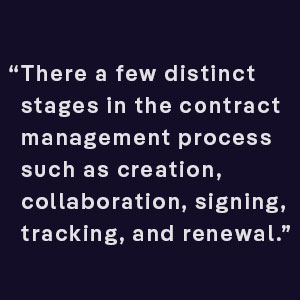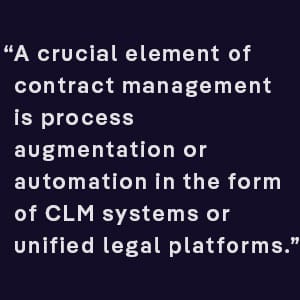Contract Management Basics
Today’s contracts govern companies’ overall relationships with employees, partners, vendors, and customers. In fact, agreements are now considered the ‘lifeblood’ of the business for that very reason.
Contract management needs to be highly efficient and effective, as a result. It must first ensure that agreements are satisfactory to all contract parties. It must then make certain these contractual relationships not only stay intact, but are also lucrative — that the business benefits from each and every agreement, and sees the most financial returns possible. So, whether you consider it a process or lifecycle, contract management not only means the development and signing of agreements, but also the employment of holistic practices that see contracts from their creation to their profitable conclusion.
To ensure your contract management meets the organization’s standards and goals, it is important to understand what happens at each essential stage. Below is everything you need to know about modern contract lifecycle management, including the key steps in this all too important process. But first, here are the very basics of contracting:
- Contract management involves managing agreements for employees, vendors, or other parties
- Contract management forms the basis of a mutually satisfactory business relationship and influences customers’ perception of companies
- Good contract management leads to the satisfactory delivery of products and services, responsive suppliers; and business benefits or financial returns
- Contract management consists of nine crucial components, within five distinct stages
- Contract managers oversee all aspects of agreements and advise senior leaders on the effectiveness of contracts
- Contract management software represents the best approach to day-to-day contracting
What is Contract Management?
Contract management — or contract lifecycle management (CLM) — touches on many departments of the organization. It is the process of managing contracts and related documents, from creation and execution to termination or renewal. It involves the authoring of agreements, the negotiation of terms and conditions, the analysis of contract performance, and compliance with deadlines and deliverables. Without effective contract management, contract parties can default on contract terms rather easily, and supplier relationships can get damaged significantly. Companies may also face both financial and reputational risks.
At the earliest stage — or pre-award phase — all of the preliminary work is done before a contract is given to the other party. During the award stage, all of the paperwork (in the proverbial sense) is completed to make agreements final. And at the post-award stage, the hard work of managing and maintaining contracts finally takes place. The contract lifecycle management process — in its entirety — is fairly involved and, yes, very time-consuming, as explained below.
Why is Contract Management Important?
Today, the average Fortune 1000 company has between 20,000 and 40,000 active contracts, on any given day. They face increasing pressure to improve performance while reducing costs tied to agreements. And as mentioned above, the most critical contracts are the very foundation of business relationships. From start to finish, the layout every part of a business deal or relationship. Good contract management, then, can mark the beginning of a mutually beneficial business relationship, paving the way for short- and long-term profitability. It also influences the way customers view the organization altogether. There are a few distinct stages in the contract lifecycle management process such as creation, collaboration, signing, tracking and renewal.
Here are the ways that effective contract management affects the top and bottom line of the business:
- Streamlines and simplifies the process of generating, negotiating, signing, and renewing agreements — contributing to quicker cycle times, reducing expenses, and increasing revenue
- Monitors contract performance and identify problem areas, ensuring the company meets all legal commitments and the other party responds to the company’s needs — creating better relationships with employees, partners, vendors, and customers
- Renews contracts with involved parties who provide the best business opportunities — further creating long-term profitability
- Provides visibility into agreements and the business — converting organizational capabilities and policies into future contract terms and conditions
- Creates standard contract processes — freeing up time for higher-level work, such as addressing new business prospects
- Monitors, assesses, and mitigates legal, procurement, and financial risk — and improves overall compliance to contracts
- Provides a peak of the company’s ability to commit to additional work — facilitating strategic decision making
What Does Good Contract Management Look Like?
When contract management is truly efficient, effective — and, therefore, successful — companies can wholly expect the following:
- Satisfactory delivery of products and services to both contract parties
- Suppliers who are completely responsive to organizational needs
- Anticipated business benefits or financial returns
- No contract disputes or surprises!
9 Components of the Contract Lifecycle Management Process
As mentioned above, effective contract management depends on the success of post-award activities. During the pre-award stage, the focus should be on the reason for creating the agreement in the first place, and whether or not the other contract party can fulfill the terms of the agreement. An understanding should be had of how the contract will work once it is awarded. But just as importantly, contract management requires both contract parties to be flexible around changing circumstances and be willing to adapt contract terms. Problems in agreements are likely to occur, after all, so companies must be ready for the unexpected.
Although there are many parts of the contract lifecycle management process, there are a few distinct stages: creation, collaboration, signing, tracking, and renewal. And within these key stages, there are rather crucial components. All of these steps make it easier to manage agreements, especially at the end of the quarter.
Here are nine components within the five overarching phases of contract management:
Contract Creation
- Initial requests (Identification of contracts and other legal documents that support the purpose of the new agreement)
- Contract authoring (Initial drafting of contracting)
- Contract collaboration
- Contract negotiation (Comparison of contract versions and the noting of discrepancies, to reduce negotiation time)
Contract Signing
- Approval of contract (Tailoring of approval workflows, to speed up contract decisions)
- Execution of contract (Control and shortening of the signature process)
Contract Tracking
- Obligation management (Assurance that deliverables are met by key stakeholders and contract value does not deteriorate, during early phases of agreement)
- Revisions and amendments (Gathering of documents relevant to the contract’s initial drafting and the amendment of the original contract)
- Auditing and reporting (Determination of contract parties’ compliance with agreement terms and possible problems that may arise)
Contract Renewal
- Renewing (Identification of renewal opportunities and creation of new agreements)
As agreements go through these stages, they need to be monitored for any changes or breaches of the contract altogether. They need to be overseen to ensure that all contractual obligations are met and both contract parties are happy with the agreement. If one party fails to meet their contractual obligations, a contract may need to be reworked or a disciplinary measure may need to be enforced. And if one party is unsatisfied with the agreement, on the whole, the latter may need amendments, however significant or small.
Responsibilities of a Contract Manager
Companies that hold hundreds — if not thousands — of contractual agreements usually have highly skilled contract managers handling them. Through their day-to-day management of contracts, these professionals oversee the legal and financial aspects of agreements and advise senior leaders on the efficiency and effectiveness of contracts in furthering the company’s goals. Their responsibilities include:
- Analyzing contractual data and responding to stakeholders
- Negotiating terms and conditions, timelines, and pricing
- Ensuring contract compliance and implementation, and resolving any conflicts or issues
- Helping teams along throughout the contracting process
According to the National Contract Management Association’s Contract Management Standard, contract managers should have the following core competencies:
- Leadership (vision and collaboration)
- Management (business, financial, project, and risk)
- Principles (contract principles, standards of conduct, and regulatory compliance)
- Pre-Award (acquisition planning, offer requesting, and business development)
- Award (price or cost analysis, negotiations, and source selection)
- Post-Award (contract administration, quality assurance, changes and modifications, and closeout)
- Learning (continuous education)
Why Legal Teams Rely on Contract Management Software
Traditionally, contract management has been characterized by paper agreements, physical folders, and filing cabinets. In recent years, it has involved scanned versions of contracts, series of emails, and shared drives. Either way, this manual process or tradition of contracting is time-consuming, costly, and error-prone. It leads to a number of contract inefficiencies, which can erode the value of these all too important legal documents. It leads to missed deadlines and compliance issues, as well as additional costs. For instance, a poorly phrased clause or simple wording mistake can cost an organization thousands of dollars over time.
So, a crucial element of contract management today is process augmentation or automation. Whether in the form of contract lifecycle management (CLM) systems or unified legal platforms, contract management software represents an electronic approach to everyday contracting. Such digital tools store and organize contracts in a central repository, and facilitate the creation, review, approval, signing, and renewal of agreements.
More specifically, automated contract management systems (CMS) provide pre-approved contract templates and clauses, or common language, to contract managers and other users. They allow for a quicker and easier contract review process, and real-time collaboration in contract negotiations. They make the entire history of an agreement completely visible (e.g. the various versions, changes, approvers, amendments, etc.).
Additionally, a contract management system monitors compliance to contract terms and conditions (e.g., payment, delivery times, quality, etc.). It tracks these key legal obligations and identifies agreements that need to change due to regulations, helping to reduce exposure to risk. And naturally, the most advanced legal technology today is powered by artificial intelligence (AI). The latter goes a long way when it comes to contract review and analysis, and overall risk management.
In other words, contract management software enables stakeholders — in multiple departments and locations — to access agreements in one place, and guides them through the entire contract lifecycle management process. It helps them author far less risky agreements for their organizations, too. And all of this automation ultimately frees up human hours and creates more value for the business.
Are you struggling with your own contract lifecycle management process? To learn more about modern contract management, read ContractPodAi’s Primer and use our handy contract management checklist. And to see how you can begin your digital transformation journey, contact us today to request a demo.




